|
RUGGEDBOOK SR820s
Samwell's mature and field-tested compact rugged Tablet PC gets a whole lot more power
(by Conrad H. Blickenstorfer, with photography by Carol Cotton)
For the past six years, Samwell's SR820 rugged tablet has been used in a host of likely and unlikely applications around the globe. Snow mobiles in Russia, airlines in Greece, motor cycles in Taiwan, food manufacturing, utility work, ATVs in precision farming, ground penetrating radar, wafer fabs, aerial laser scanning, metal casting, utility meter system reading, and field invoicing are just a few of the places and applications that saw RUGGEDBOOK SR820 tablets in action. It was a design truly ahead of its time, and now Samwell has given it a new lease on life with a big performance upgrade. In this article, we describe what the SR820 platform is, and what the new SR820s model means.

As is, the RUGGEDBOOK SR820s fills two needs. With a weight of under three pounds it can be used as a smaller, lighter version of a standard full-size rugged tablet computer. And with a footprint almost identical to what the once so popular netbooks used to be, it can serve as a ruggedized tablet version of a small Windows laptop. Also a factor in many applications, the SR820s is completely silent because it doesn't need a fan and there isn't a rotating hard disk.
However, while the smaller size, lower weight and low price of netbooks compared to full notebooks meant customers were giving up features and performance, the same does not hold true for scaled-down tablets, at least not to the same extent. The SR820's 8.9 inch wide-format display is large enough for real work, and while its native 1024 x 600 pixel resolution sounds low compared to modern smartphones with their full HD or even 4k pixel counts, it is actually the same pixel density as that of the original iPads and more than the 800 x 600 pixel SVGA resolution used in full-size tablets for many years.
Taking a look at the RUGGEDBOOK SR820s
Unlike some of the rugged tablets we've reviewed, the RUGGEDBOOK SR820s, compact though it is, doesn't look like a miniaturized and slenderized version of a full-size tablet. It measures 10.1 x 6.2 inches and is an inch and a half thick. It weighs about three pounds. Its 8.9-inch touch screen looks large enough. And unlike some lightweight tablets, it has a full complement of I/O ports, and they are all full size. Available operating systems include Windows Embedded Standard 7 and Windows Embedded 8.1 Pro. Our eval unit came with the latter.
The design is purposeful but not fancy. There are no chrome, black gloss or other trendy stylistic elements here; the SR820s is just a matt-black magnesium tablet with rubber bumpers on each corner to provide additional protection. There is no keypad and there are no hardware controls other than a number of large and very clearly marked membrane pushbuttons along the right side of the display.

Looking at the computer from all sides, there are ports underneath individual protective rubber plugs on the left and right, and a surface-mount docking connector at the bottom. There are two additional cutouts each on top and on the bottom of the unit. They are used to accommodate antennas and optional expansion functionality.
Design and construction
While the RUGGEDBOOK SR820s may look like just a tablet version of a very small notebook, looks deceive. The SR820s is far better built than any consumer device, and it is far tougher and more durable. The unit feels as if it were crafted from a solid block of metal, and there is no flexing or twisting whatsoever.
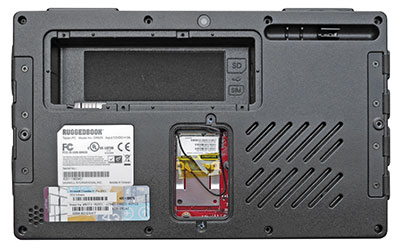 Unlike the often very intricate housing/chassis constructions found in consumer tablets and notebooks, the supremely solid magnesium alloy case of the SR820s consists of just a lower box with the LCD lid on top of it, held together by ten long screws. Unlike the often very intricate housing/chassis constructions found in consumer tablets and notebooks, the supremely solid magnesium alloy case of the SR820s consists of just a lower box with the LCD lid on top of it, held together by ten long screws.
Sealing consists of an easily replaceable rubber O-ring sitting in a groove around the entire perimeter. It is not actually a ring, but a length of rubber, that terminates with a sort of side-track.
There are two removable covers on the backside of the Ruggedbook SR820s (both removed in the picture to the right). One of them covers the battery and expansion slots, the other a compartment for the optional WWAN module.
The battery compartment is protected by a flat metal plate secured with four Philips screws. The battery itself is a rectangular block. Its capacity is 38 watt-hours (7.4 Volts, 5,200mAh).
The battery contact block is not sealed towards the interior of the computer, so all sealing must be via the cover plate. To accomplish that, there is a flat ribbon O-ring seal that's held in place via a series of tiny pins. For proper sealing it's imperative that the seal, which is a bit of a dust and lint magnet, is in place and not compromised in any way.
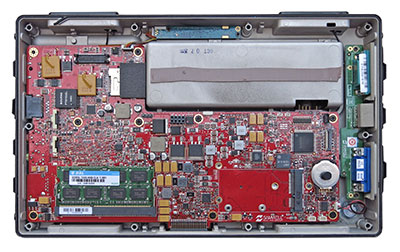 Inside the SR820s, the Samwell-labeled motherboard is extremely clean. It has fixed edge connectors on one side, and a separate I/O module on the other side. Having a discrete I/O module makes customization easy. Inside the SR820s, the Samwell-labeled motherboard is extremely clean. It has fixed edge connectors on one side, and a separate I/O module on the other side. Having a discrete I/O module makes customization easy.
The housing has four separate small compartments, two on top and two at the bottom, for antennae. This design places the antenna bays effectively outside of the metal housing for optimal reception.
RAM memory in our test unit consisted of a DSL branded DDR3L 1333 4GB CL9 1.35V module in the tablet's single SO-DIMM slot (see on the lower left). To the right of it is a full-size PCIe slot that was unoccupied in our unit, but is usually used for a WWAN radio module.
Samwell offers two different I/O configurations. One adds a standard DB-9 RS232 serial port, the other replaces that port with the window for the optional industrial-grade 1D/2D laser scanner. Our test unit included the following ports:
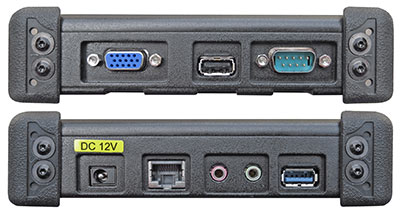
- 1 x USB 2.0
- 1 x USB 3.0
- 1 x VGA
- 2 audio jacks
- 1 RJ45 LAN
- 1 x DB9 RS232
- surface mount docking/port replicator connector
The optional docking station adds three USB ports, a RS232 serial port, a LAN port, and DC power. The dock attaches to the bottom of the unit and also provides vehicle mounting options.
The image below shows the SR820s strapped into the optional dock, here shown with RAM's patented ball and socket mounting system that allows you to mount practically anything anywhere (see RAM Mount site).

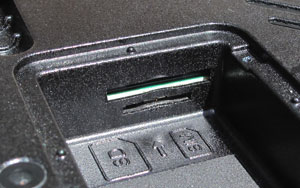 For expansion, the battery compartment also contains the unit's SD Card slot and a SIM slot (shown in the picture to the left) for use with units equipped with the optional WWAN module. Having the SD Card slot inside the unit, and under a screw-down door, means the card is safe, but it is also not readily accessible. For expansion, the battery compartment also contains the unit's SD Card slot and a SIM slot (shown in the picture to the left) for use with units equipped with the optional WWAN module. Having the SD Card slot inside the unit, and under a screw-down door, means the card is safe, but it is also not readily accessible.
The one concern I have about the design is that the various I/O openings completely rely on the protective rubber plugs for sealing, i.e. the connectors behind the protective plugs do not have additional sealing. The plugs fit very well and they are replaceable, but you have to firmly push them into place to get a reliable seal, and that may not always be easy when you wear gloves or when it's cold out there in the field.
Intel Bay Trail: Not your father's Atom
If the original SR820 had a flaw, it was the only adequate performance of its Atom Z530P processor. Designed by Intel to combat the emerging flood of inexpensive ARM-based processors used in smartphones and tablets, early generation Atom chips simply didn't have enough punch to power full implementations of Windows at an acceptable clip.
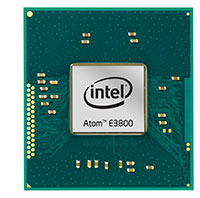 Intel's description at the time was "targeted" performance, i.e. just enough for a specific job, no more and no less. While that works for many embedded applications where systems only perform a single, predictable task, that's not how most people use their computers. Intel got a massive boost from Atom-powered netbooks that sold in the tens of millions, but were just as quickly abandoned by consumers who were attracted by the low cost, but turned off by the low performance. Intel's description at the time was "targeted" performance, i.e. just enough for a specific job, no more and no less. While that works for many embedded applications where systems only perform a single, predictable task, that's not how most people use their computers. Intel got a massive boost from Atom-powered netbooks that sold in the tens of millions, but were just as quickly abandoned by consumers who were attracted by the low cost, but turned off by the low performance.
Several successive generations of Atom chips never really solved the performance issue, until Bay Trail came along. Bay Trail represents a departure from Intel's product strategy of the past few years that differentiated between low end (Atom) and high end (Core) processors. Instead, Bay Trail consists of a large family of single, dual, and quad processor chips optimized for various types of devices. Lower end Bay Trail processors use Intel's "Atom" brand, whereas higher end versions targeting tablets, notebooks and desktops carry Intel's "Celeron" and even "Pentium" brand names.
Further, for the first time, an Intel Atom microprocessor architecture is paired with genuine Intel HD Graphics. The graphics cores integrated into Bay Trail systems are of the same HD 4000 architecture and variety as those used in Intel's 3rd generation "Ivy Bridge" processors, albeit with fewer execution units (four instead of several times that number) and lower clock speeds.
|
PassMark 6.1
|
Samwell
|
Samwell
|
|
Model
|
RUGGEDBOOK SR820s
|
RUGGEDBOOK SR820
|
|
Year tested
|
2015
|
2010
|
|
OS
|
Windows Embedded 8.1 (32-bit)
|
Windows XP Tablet (32-bit)
|
|
Processor Type
|
Intel Atom
|
Intel Atom
|
|
Processor Model
|
E3845
|
Z530P
|
|
Processor Codename
|
Bay Trail
|
Silverthorne
|
|
CPU Speed
|
1.91Hz
|
1.60Hz
|
|
Cores/threads
|
4/4
|
1/1
|
|
Lithography
|
22nm
|
45nm
|
|
L2 cache
|
2,048KB
|
512KB
|
|
Graphics
|
Intel HD Graphics (6 EUs)
|
Intel GMA 500
|
|
USB 3.0
|
yes
|
no
|
|
Thermal Design Power (TDP)
|
10.0 watts
|
2.0 watts
|
|
CPU Mark
|
1,260.6
|
248.79
|
|
2D Graphics Mark
|
150.4
|
101.8
|
|
Memory Mark
|
321.5
|
222.5
|
|
Disk Mark
|
1,519.4
|
218.6
|
|
3D Graphics Mark
|
130.0 (est.)
|
18.6
|
|
Overall PassMark
|
738.8
|
167.4
|
|
CrystalMark
|
|
|
|
ALU
|
20,648
|
5,272
|
|
FPU
|
18,894
|
4,571
|
|
MEM
|
21,011
|
3,969
|
|
HDD
|
27,724
|
3,678
|
|
GDI
|
4,551
|
2,806
|
|
D2D
|
3,000 (est)
|
1,048
|
|
OGL
|
3,135
|
346
|
|
Overall CrystalMark
|
98,963
|
21,690
|
The new graphics support most of the same APIs and features, including DirectX 11, OpenGL 4.0, and OpenCL 1.2. Better yet, the clever power-saving "active idle" feature from Haswell core processors is apparently there as well.
Bay Trail gave manufacturers an entire new lineup of economically priced processors for a wide variety of platforms where cost and size mattered, but where customers still expected enough performance to get the job — any job — done.
Samwell decided on the quad-core Atom E3845, the top-of-the-line of the E3800 product family that Intel described as "the first system-on-chip (SoC) designed for intelligent systems, delivering outstanding compute, graphical, and media performance while operating in an extended range of thermal conditions." This chip is in an entirely different league from the old Z530P. For a detailed side-by-sideof the old and the new chip, see here.
The table above shows a comparison between the two chips. Over half a decade's worth of progress plus a fundamental change in Intel's mindset are clearly obvious. The new chip is superior in every respect, by a lot. That is evident from the specs alone, and backed up by stellar benchmark performance. Overall bottomline performance of the new SR820s is in the 4.5X range compared to the old SR820.
That is massive. Especially since our test unit was still only an engineering sample that was not yet firing on all cylinders. Production versions may well run 20-30% faster yet. Note that while the new chip is certainly at the center of all this new-found speed, a switch from rotating hard disk to speedy solid state storage also helped a great deal.
Further note, as always, that benchmarks are only an approximate indicator of performance, and that they can yield unexpected or misleading results when different processor architectures are being compared. However, after having conducted many hundreds of benchmarks in the RuggedPCReview.com lab, we found that the bottomline is usually a good indication of a system's actual overall performance.
In real live use, our test RUGGEDBOOK SR820s felt quick and responsive, and it should be up to just about any job.
Competent 8.9-inch display
The SR820s's LCD comes from Chi Mei, which is one of the largest LCD manufacturer in the world. It is their model N089L6-L02 WSVGA display with LED backlight, vertical striping, 3H hard coating, and 180 nit brightness. It has a 40-pin LVDS interface, and can display 256k colors. Lifetime of the LED light bar is 15,000 hours (which means you'll likely never have to replace it), horizontal viewing angle is 45 degrees in each direction, vertical viewing angle a more modest 20 degree up and 45 degree down.
Like most tablet computers, the RUGGEDBOOK SR820s will likely see a lot of outdoor duty where the display must be viewable under a variety of lighting conditions. Our review unit came with the optional sunlight-viewable display.
Since the SR820s display doesn't appear to have changed from the original SR820, the comparisons below are from our initial SR820 review. The first picture shows an outdoor comparison between the SR820 and an older Acer Aspire One netbook (which is still doing yeoman duty in our office). The SR820's display is a bit brighter and hugely more readable thanks to very effective anti-glare coating. The Acer's glossy screen, on the other hand, has so much reflection as to render it practically useless.
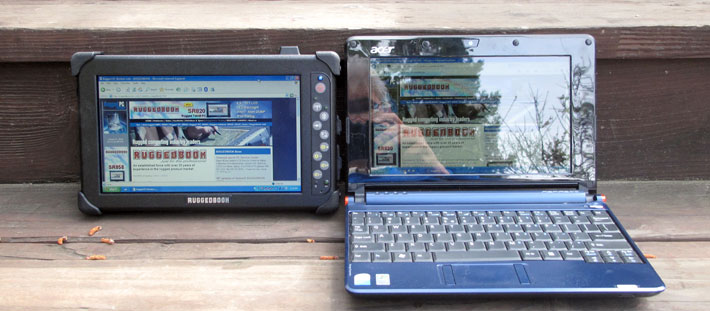
When looked at from an angle, the SR820 display remains perfectly readable, although it loses some of its brightness. The Acer's gloss screen and glossy bezel, on the other hand, would be a nightmare for outdoor work.
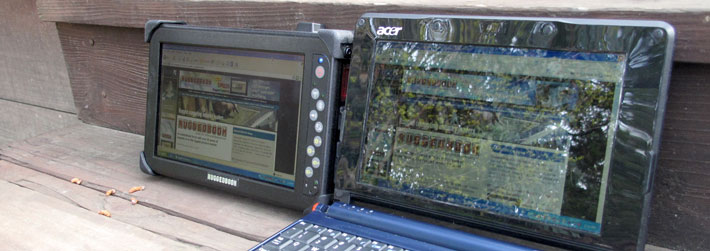
In direct sunlight, no backlight is strong enough to be a match for the sun, so Samwell's decision to stay with a relatively modest backlight that will not quickly drain the battery seems reasonable. To its credit, the consumer market Acer netbook remains readable as well, especially without much background to reflect.
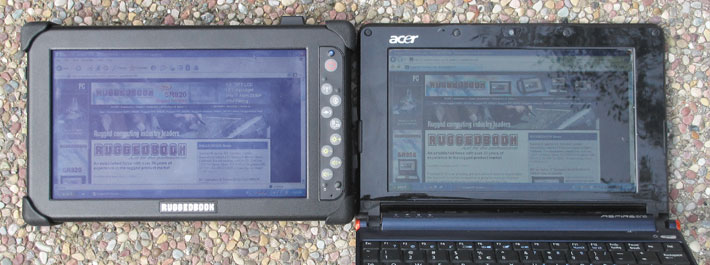
As far as display size and resolution go, nine inches diagonal is perfectly adequate, although the 1024 x 600 WSVGA display resolution is now marginal, especially for Windows 8.1 users. Dimming is via hardware controls in eight steps, but does not go down to 0%. The narrow vertical viewing angle means you have to look at the display from just the right angle to get the best picture. One drawback of WSVGA is that it tends to cut off the bottom of web pages and applications designed for full 1024 x 768 XGA resolution; if that is a problem, you can set the SR820s to interpolated XGA mode. It loses a bit of crispness that way, and the aspect ratio is off a bit, but it's a workable solution.
Resistive digitizer doesn't mind rain
The SR820s still has a 4-wire resistive touch screen that can either be used with the small supplied telescopic stylus or with a finger. While virtually all consumer tablets (and an increasing number of industrial tablets) now use projected capacitive multi-touch, resistive touch remains a viable, and often preferred, solution in many applications. That's because it works in wetness and rain, and it can be operated with any passive stylus or even a fingernail. That can be invaluable.
The panel is configured with the PenMount control panel that includes three settings screens as follows:
Calibrate handles touch calibration using 4, 9, 16, or 25 points, with 25 points offering the maximum accuracy. In advanced mode you can opt to show calibration data.
Setting lets you selected either mouse emulation mode or click-on-touch, enable a beep sound to occur on pen down or pen up (or both), and even set its frequency and duration. I am not sure how that would be used, but in noisy vehicle operation, having auditory feedback to confirm a touch operation may come in handy. You can also engage a cursor stabilizer to eliminate cursor jitter, and you can set how the digitizer should handle right clicks.
Edge compensation determines how the digitizer acts along the perimeter of the display where it is sometimes hard to accurately control the cursor.
Below you can see the three PenMount configuration screens.

As long as the inherent pros and cons of resistive technology are understood, the SR820s's resistive touch panel works well, and especially so with the supplied small stylus. It does, however, not allow taking full advantage of the many older Microsoft and third party pen utilities that were mostly designed for use with an active inductive digitizer, and it's also not optimal for use with Windows 8.1 that was designed for capacitive touch.
Ruggedness: field-proven
As the brand name implies, the RUGGEDBOOK SR820s is fully rugged. Its no-nonsense magnesium construction feels like it is made to last, and it can take quite a beating. This inherent toughness is enhanced by rubber bumpers on all corners are actually steel caps with rubber on top. This makes them far more stable than rubber-only bumpers, and they attach very securely to the unit without the need of glue. The picture to the right shows one of the bumpers.
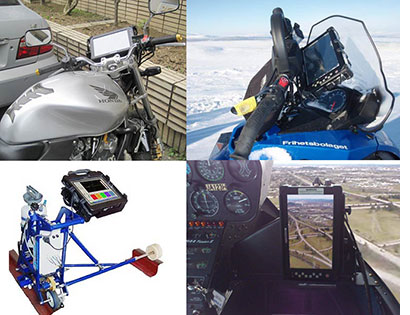 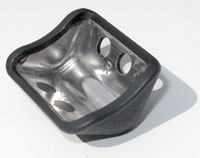 Samwell performed a variety of MIL-STD-810G testing, both in their inhouse lab and through SGS Group external testing. The SR820s carries a 4-foot drop spec which indicates that it passed the MIL-STD 810G Method 516.6 Procedure VI "Drop" test that includes 26 drops to concrete on each face, edge and corner from 48 inches. It also passed mechanical shock, random vibration, temperature/humidity cycling as well as high/low temperature tests. Samwell performed a variety of MIL-STD-810G testing, both in their inhouse lab and through SGS Group external testing. The SR820s carries a 4-foot drop spec which indicates that it passed the MIL-STD 810G Method 516.6 Procedure VI "Drop" test that includes 26 drops to concrete on each face, edge and corner from 48 inches. It also passed mechanical shock, random vibration, temperature/humidity cycling as well as high/low temperature tests.
As far as sealing against the elements goes, the SR820s carries an IP65 ingress protection where the "6" means complete protection against dust penetration, and the "5" means protection against low pressure water jets from all directions, with limited ingress permitted. The original SR820 only carried IP54 protection, and at the time we concluded that the overall construction of the machine looked like it could easily pass IP65 standards. Samwell informed us that the SR820 had actually passed independent IP65 testing as well, and that's what the new SR820s is rated for. The draft product brochure even claims IP68, which would mean unlimited immersion in water.
The standard operating temperature range is -14 to 122 degrees Fahrenheit, good enough for virtually all deployment. That's another much appreciated improvement over the original SR820, which was only rated down to 32F even with a solid state disk. With a rotating hard disk (which is no longer offered), the old unit could only handle 41 degrees.
The pictures below show some of the independent ruggedness testing performed at SGS Group labs.

Summary: Samwell RUGGEDBOOK SR820s
The Samwell RUGGEDBOOK SR820s represents a major performance upgrade to Samwell's long-running, popular SR820 tablet platform. Users of the original SR820 can expect a massive speed and responsiveness improvement, especially if they are migrating from older units with rotating storage. Even compared to brand-new designs, the upgraded SR820s can hold its own thanks to its thoroughly modern quad-core Intel Bay Trail processor and ancillary electronics.
In terms of size and weight, the SR820s remains just right. Measuring 10.1 x 6.2 x 1.5 inches and weighing under three pounds, the SR820s is smaller and lighter than full-size rugged tablets without many compromises. Its 8.9-inch touch screen is large enough to be useful, though the 1024 x 600 resolution (1024 x 768 interpolated) is no longer state of the art. There is a decent 5mp camera, excellent wired connectivity on board, all the connectors are standard size, and there is a wealth of wireless functionality (including available GPS and LTE/3G radio) and also an optional laser scanner.
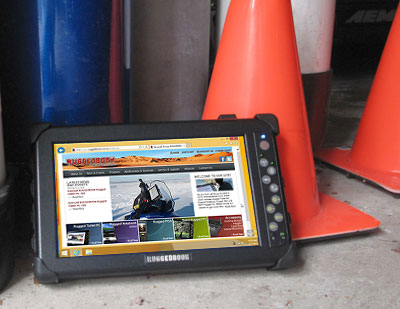 The new-found performance is courtesy of a 1.91GHz quad-core Intel Atom E3845 processor that provides a nice balance between good performance and decent battery life, thanks to the very low heat dissipation of the processor all without the need of a fan. Heavy-duty multimedia that was impossible on the original SR820 is no longer a problem on the new unit, as it feels quick and responsive in every situation. And even with much more speed, the 38 watt-hour battery still lasts up to six hours on a charge. The new-found performance is courtesy of a 1.91GHz quad-core Intel Atom E3845 processor that provides a nice balance between good performance and decent battery life, thanks to the very low heat dissipation of the processor all without the need of a fan. Heavy-duty multimedia that was impossible on the original SR820 is no longer a problem on the new unit, as it feels quick and responsive in every situation. And even with much more speed, the 38 watt-hour battery still lasts up to six hours on a charge.
The 8.9-inch display is bright and plenty sharp enough, and offers good outdoor viewability without any glare. The resistive touch screen works well and is highly configurable, but does, of course, not offer the smooth inking of an active digitizer or the effortless tapping, panning and zooming of a capacitive multi-touch screen.
For a very compact tablet computer, the SR820s has excellent onboard connectivity with USB, LAN, VGA, audio and either a serial port or a laser scanner, as well as additional connectivity via the optional dock. For onboard storage expansion there is a user-accessible SD card slot in the battery compartment. The integrated 5-megapixel camera offers good image quality for documentation, and the new USB 3.0 port offers much higher transfer speeds.
The SR820s's nicely designed magnesium alloy chassis, rock-solid construction, and steel-backed rubber bumper protection combine to make a rugged, durable tablet computer able to withstand accidents and exposure to the elements in the field. The device is also well-sealed with individual rubber plugs, though we'd like to see the actual ports sealed as well.
With the RUGGEDBOOK SR820s, Samwell provides a much appreciated enhancement to a rugged tablet platform that has been proving itself for years under even the most demanding operating conditions.
-- Conrad H. Blickenstorfer, April 2015
Samwell RUGGEDBOOK SR820s Specs:
| Status |
Added 04/2015
|
| Type |
Rugged Tablet PC (fanless design)
|
| Processor |
1.91GHz Intel "Bay Trail" Atom E3845 with 2MB L2 cache |
| Display Chipset |
Integrated |
| Graphics |
Intel HD Graphics |
| OS |
Windows Embedded Standard 7, Windows Embedded 8.1 Pro |
| Memory |
4GB or 8GB DDR3L 1333MHz in one slot |
| Display |
8.9" WSVGA (1024 x 600 pixel) TFT with LED backlighting; optional sunlight readable version |
| Digitizer |
4-wire resistive touch screen |
| Keyboard |
Onscreen keyboard |
| Navigation |
Stylus, touch |
| Storage |
64GB SATA/600 solid state disk, optionally up to 256GB SSD |
| Expansion slots |
1 SDXC Card + 1 SIM |
| Housing |
Magnesium alloy chassis/housing, rubber bumpers |
| Size |
10.1" x 6.2" x 1.5" (inc. rubber bumpers) |
| Weight |
2.9 pounds as tested (with battery and bumpers) |
| Operating temperature |
MIL-STD-801G, Method 501.5 Procedure II; MIL-STD-801G, Method 502.5 Procedure I: -14°F to 122°F (-10°C to 50°C) |
| Temperature/humidity |
MIL-STD-801G, Method 507.5 |
| Ingress protection |
IP65 |
| Altitude |
15,000 feet operating per MIL-STD-810G, Method 500.5, Procedure II |
| Drop/shock |
MIL-STD 810G, 506.6 VI: 4-foot drop, over concrete, onto each edge, face and corner (26 drops total) |
| Shock |
MIL-STD 810GF, 516.5 Procedure I: 40G sawtooth pulse while operating (3 shocks each axis, 18 total) |
| Salt Fog |
NA |
| Vibration |
Per SGS test report: random wave forms 1-200 Hz 90 min per axis |
| Power |
4-cell Li-Ion 5,900mAH ("6 hrs") |
| Interface |
1 x USB 2.0, 1 x USB 3.0, 1 x RS232 (or barcode scanner), 1 x RJ45, 1 x VGA, audio in/out, integrated 5-megapixel camera with autofocus |
| Wireless options |
802.11b/g/n WiFi + Bluetooth V4.0; optional integrated GPS, 1D or 1D/2D barcode scanner, 3G/LTE mobile broadband (WWAN uses mini-PCIe slot), RFID reader
|
| Price |
Inquire |
| Contact |
Samwell Group |
(copyright 2015 RuggedPCReview.com)
|



